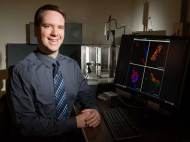Voice exercise with singing rats show hope for age-related voice problems
 Researchers at the University of Illinois and the University of Wisconsin showed that the vocal training of older rats led to the reduction of some of the voice problems associated with aging, such as the loss of vocal intensity that accompanies changes in the muscles of the larynx. The results hold promise that voice therapy could be used to improve vocal abilities and quality of life for the elderly.
Researchers at the University of Illinois and the University of Wisconsin showed that the vocal training of older rats led to the reduction of some of the voice problems associated with aging, such as the loss of vocal intensity that accompanies changes in the muscles of the larynx. The results hold promise that voice therapy could be used to improve vocal abilities and quality of life for the elderly.
According to researchers, aging can cause the muscles of the larynx, the organ involved in breathing and sound production, to atrophy. This condition, called presbyphonia, may be treated with vocal training. The larynx houses the vocal folds which are essential for phonation.
In a young and healthy larynx, the vocal folds are completely close and open during vibration and this creates little puffs of air we hear as sound. On the other hand, the atrophied vocal folds do not close properly, resulting in a gap during vocal fold vibration.
What additionally contributes to the symptoms of presbyphonia is degradation of the neuromuscular junction – the interface between the nerve that signals the vocal muscle to work and the muscle itself. In a healthy person, when the signal reaches the neuromuscular junction, it causes a release of chemicals that signal the muscle to contract. However, an age-related decline in the neuromuscular junction can induce weakness and fatigue in the muscle and consequently person have a breathy or weak voice.
The gap between the vocal folds seen in presbyphonia may be corrected by means of surgery or injections, but these procedures are invasive and often not viable for the elderly population.
The research team used a rat model to find out whether vocal training could have an effect on the strength and physiology of the vocal muscles in humans. Namely, rats and humans use similar neuromuscular mechanisms to vocalize, making rats an ideal model organism for the study of human vocal characteristics. Because rats make ultrasonic vocalizations that are well above the range of human perception, researchers used special recording equipment and a computer that lowers the frequency of the sound produced by rats.
Both the treatment and control groups consisted of old and young male rats. The treatment would start with a placement of a female rat placed into a cage with a male rat. When the male showed interest in her, the female was removed from the cage. As a consequence, the male rat produced sound and he was then rewarded with food for certain vocalizations.
After eight weeks, all of the rats in the treatment group had been trained to increase their number of vocalizations during a training session. At the end of the experiment, the researchers found that trained old and young rats had similar average vocal intensities, but the untrained older rats had lower average intensities than both the trained rats and the young rats. As for the neuromuscular mechanisms, they found several age-related differences within the groups.
“Other research has found that in the elderly, there is a dispersion, or breaking apart, of the neuromuscular junction at the side that is on the muscle itself. We found that in the older rats that received training, it wasn’t as dispersed”, said Aaron Johnson, speech and hearing science professor at the University of Illinois.
According to UIUC researchers, these “singing rats” are the first evidence that vocal use and vocal exercise can change the neuromuscular system of the larynx. Even though this study wasn’t conducted on humans, researchers strongly believe that we can train ourselves to use our voices to reduce the effects of age on the muscles of our voices and improve the voices that have degraded.
For more information, read the article published in the Journals of Gerontology: “Vocal Training Mitigates Age-Related Changes Within the Vocal Mechanism in Old Rats“.









Leave your response!